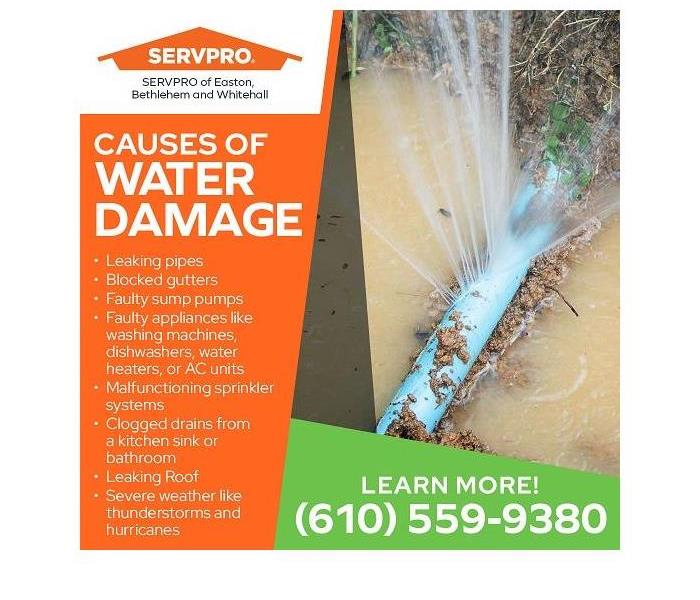What is Water Damage and its Classes and Categories?
2/4/2022 (Permalink)
Blog Summary: What water damage is, its causes, and types are outlined by SERVPRO of Easton, Bethlehem and Whitehall.
Water damage is a common cause of property damage in the United States. Industry estimates place the number of people experiencing a water damage emergency at homes or workplaces at 14,000 a day. Insurance companies pay billions of dollars every year on claims related to water damage and subsequent mold. Household water leaks cause a trillion gallons of water loss a year.
The figures above reveal why water damage is something to be aware of and prevented, as far as possible. SERVPRO of Easton, Bethlehem and Whitehall explains what water damage is.
According to Wikipedia, water damage describes the possible losses caused by water intruding where it will enable the attack of a material or system by destructive processes like the rotting of wood, mold growth, bacterial growth, rusting of steel, swelling of composite woods, delamination of materials like plywood, etc. In general, any destruction of property interiors or external structures of a building from a water related source is water damage.
Water damage can affect buildings in many ways. There can be floor warping, discoloration of walls, mold formation, vermin infestation, and even weakening of foundations. Water damage is sudden and can cost a lot to repair and restore. Hence, quick and professional water damage restoration services are important to limit the damage and expenses.
Causes of Water Damage
Leaking pipes
Blocked gutters
Faulty sump pumps
Faulty appliances like washing machines, dishwashers, water heaters, or AC units
Malfunctioning sprinkler systems
Clogged drains from a kitchen sink or bathroom
Leaking Roof
Severe weather like thunderstorms and hurricanes
It must be noted that from the perspective of insurance, flood damage is considered different from water damage. Damage resulting from floods is covered by separate insurance that homeowners in flood-prone areas can choose to purchase. Water damage also has to be sudden and accidental. Insurance claims typically will not cover water damage caused by negligence and poor maintenance of homes.
Classification of Water Damage
The class of damage a water damage incident falls into is determined by the degree of damage to the property. There are four classes of water damage.
Class 1
Class 1 water damage is caused by uncontaminated water and minimal water absorption, affecting either a portion of a room (less than 5% of the total square footage including floors, walls and ceilings) or an area where materials have low porosity and the room has a slow evaporation rate.
Class 2
An entire room is affected but only 5-40% of the entire square footage of the room (floors, walls and ceilings). There is the presence of porous materials such as carpet and carpet padding which absorb water needing extraction. Water may have wicked up the wall less than 2 feet, and there is moisture in structural materials. This class of damage has a fast evaporation rate and the time required to dry the area will increase.
Class 3
More than 40% of the total square footage of the impacted area is affected. There is significant water absorption in the flooring, insulation, subflooring, structural materials, and water has wicked up the walls at least 2 feet. Class 3 water damage has the fastest evaporation rate. Water removal will take longer and may require special equipment to dry sufficiently. This class of water damage usually results from an overhead source such as a burst pipe in the ceiling or water intrusion from the roof.
Class 4
Class 4 water damage means a significant amount of water has had time to be absorbed into low porosity materials like plaster, hardwood flooring, and concrete. Water removal in this class of damage is complex and water damage restoration will require specialized equipment and takes more time to remediate than the other classes.
Categories of Water Damage
Based on the level of contamination of water causing damage within a building, there are 3 categories of water damage.
Category 1 Water - here the source of water is sanitary or considered to be minimally contaminated, hence referred to as clean water. This includes tub or sink overflows, and broken water supply lines.
Category 2 Water – water causing damage contains contaminants that can lead to discomfort or health effects if consumed. This is called gray water. Water is usually from appliances like dishwashers or washing machines, water beds, aquariums, or toilet bowls with urine (no feces).
Category 3 Water – is grossly contaminated water called black water. Black water is highly unsafe and should not be consumed or handled without proper safety measures in place. This water includes sewage, seawater, water rising from rivers or streams, storm surge, toilet backflows, etc.
Water damage restoration is best started as quickly as possible. Water damage affects property, possessions, and treasured keepsakes. Apart from the damage to furniture, appliances, electronics, and documents, even the structure of buildings can be damaged.
Water damage affects homeowners physically, financially, and emotionally. SERVPRO of Easton, Bethlehem and Whitehall understands the stress that comes with water damage and the associated disruption caused to the life of a homeowner or business owner. Their highly trained staff offers professional water damage restoration services. They can be contacted on (610) 559-9380 or via email at SERVPRO5770@SERVPROofeaston.com





 24/7 Emergency Service
24/7 Emergency Service
